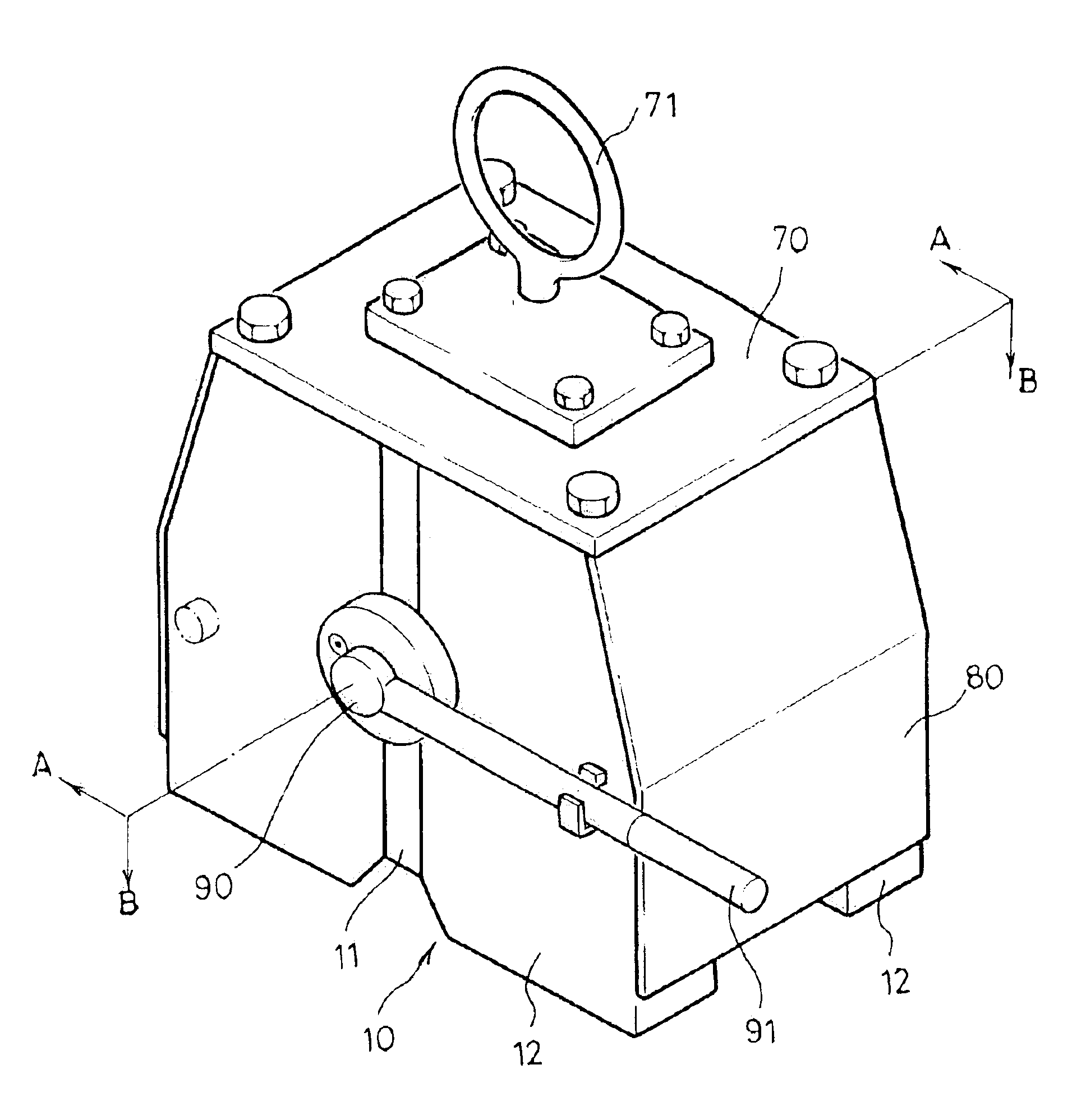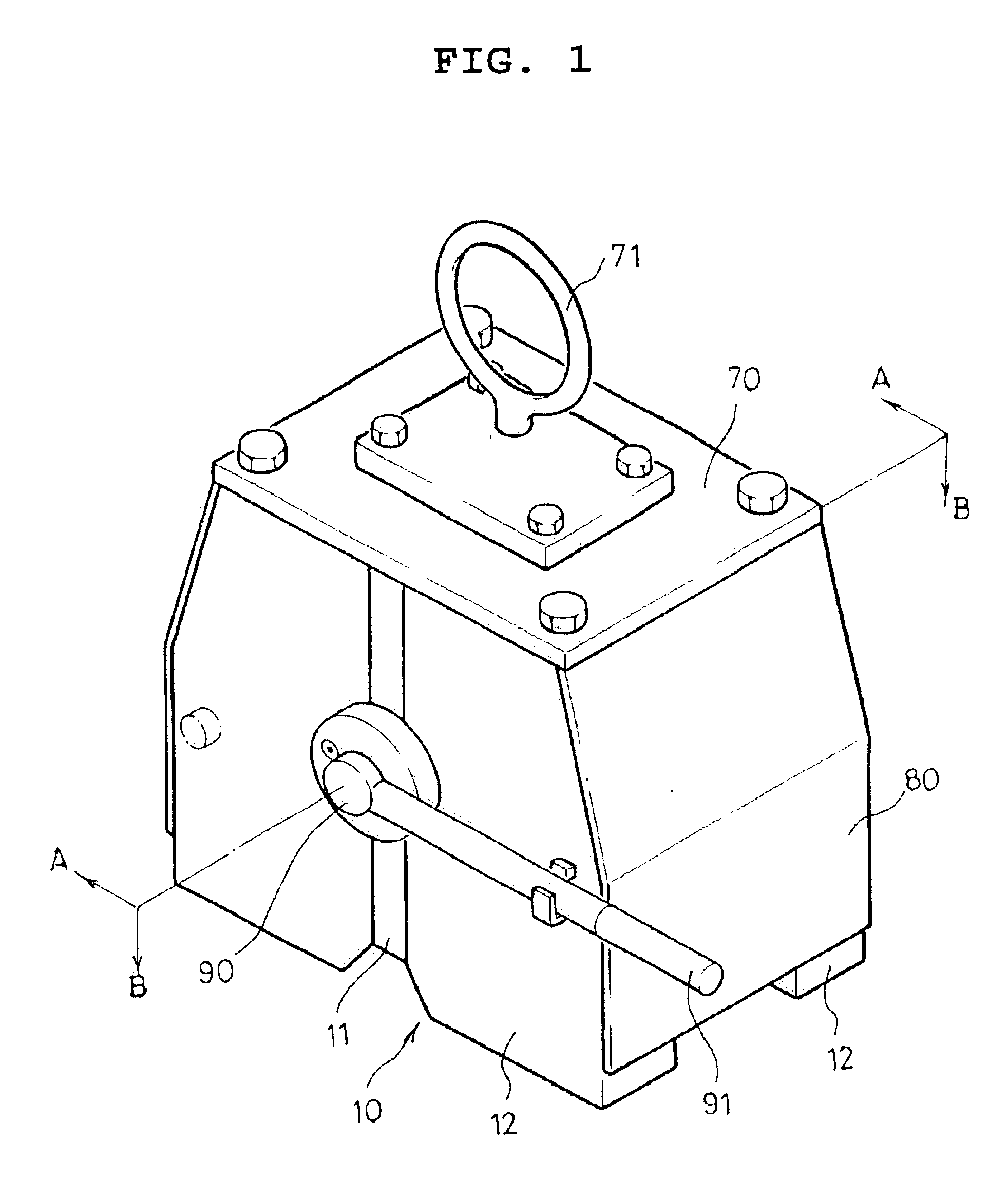Magnetic lifting machine using neodymium magnets
a technology of neodymium magnets and lifting machines, which is applied in the direction of magnetic bodies, wellbore/well accessories, manufacturing tools, etc., can solve the problems of high manufacturing cost, lowering magnetization, and exfoliation of the coated film on the magnet, so as to reduce friction, improve credibility and commercial applicability of the machine, and rotate the rotor smoothly
- Summary
- Abstract
- Description
- Claims
- Application Information
AI Technical Summary
Benefits of technology
Problems solved by technology
Method used
Image
Examples
second embodiment
Referring to FIG. 7, the magnetic lifting machine according to the present invention will be described.
As all the constitutional parts of the magnetic lifting machine in the second and subsequent embodiments are the same as those in the first embodiment with the exception of means for fitting the anti-exfoliation plates into the rotor, reference numerals used in the first embodiment will also be used in the second and subsequent embodiments for identical parts of the machine, and description on the identical parts will be omitted.
In the second embodiment, the rotor (20) is formed in the shape of a cylinder and has the central support (21) integrally formed along the diameter to divide the cylindrical rotor into two receptacles (22). The central support (21) in the second embodiment, however, is inwardly dented on both sides of the rotor (20) by the thickness of anti-exfoliation plates (41), and its thickness is the same as that of the neodymium magnets (30) fitted into the receptacl...
third embodiment
Referring to FIG. 9, the magnetic lifting machine according to the present invention will be described.
In the third embodiment, anti-exfoliation plate (42) are shaped in the form of a ring having the outside diameter slightly smaller than the inside diameter of the rotor (20) and the inside diameter slightly larger than the outside diameter of the boss (21a) of the central support (21). Each of the anti-exfoliation plates (42) has two concaved parts (42a) in opposite along the arms (21b) of the central support (21) of the rotor (20). In the center of each of the concaved parts (42a), a hole for bolt (42b) is formed.
The rotor (20) is formed in the shape of a cylinder and has the central support (21) integrally formed along the diameter to divide the cylindrical rotor (20) into two receptacles (22). The central support (21) has the boss (21a) in the center having the same thickness as the periphery of the rotor (20) and also has a pair of arms (21b), each of which is inwardly dented o...
fourth embodiment
Referring to FIG. 11, the magnetic lifting machine will be described.
In the fourth embodiment, anti-exfoliation plates (43) are shaped in the form of a ring having the outside diameter slightly larger than the outside diameter of the rotor (20) and the inside diameter slightly larger than the outside diameter of the boss (21a) of the central support (21). Each of the anti-exfoliation plates (41) has an extended flange (43a) along its periphery and two concaved parts (43b) in opposite along the arms (21b) of the central support (21) of the rotor (20). In the center of each of the concaved parts (43b), a hole for bolt (43c) is formed.
The rotor (20) is formed in the shape of a cylinder and has the central support (21) integrally formed along the diameter to divide the cylindrical rotor (20) into two receptacles (22). The central support (21) has the boss (21a) in the center having the thickness slightly larger than that of the periphery of the rotor (20) and also has a pair of arms (21...
PUM
| Property | Measurement | Unit |
|---|---|---|
| magnetic flux density | aaaaa | aaaaa |
| magnetic flux density | aaaaa | aaaaa |
| magnetic performance | aaaaa | aaaaa |
Abstract
Description
Claims
Application Information
 Login to View More
Login to View More - R&D
- Intellectual Property
- Life Sciences
- Materials
- Tech Scout
- Unparalleled Data Quality
- Higher Quality Content
- 60% Fewer Hallucinations
Browse by: Latest US Patents, China's latest patents, Technical Efficacy Thesaurus, Application Domain, Technology Topic, Popular Technical Reports.
© 2025 PatSnap. All rights reserved.Legal|Privacy policy|Modern Slavery Act Transparency Statement|Sitemap|About US| Contact US: help@patsnap.com



